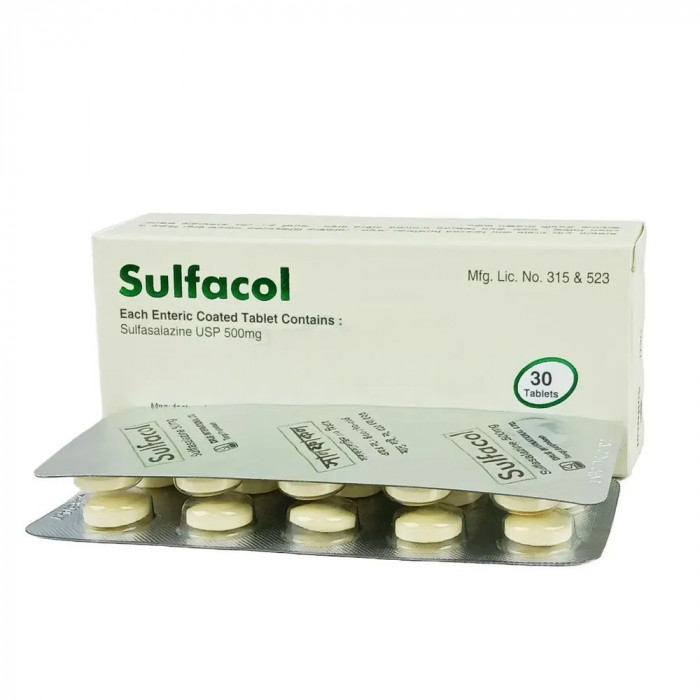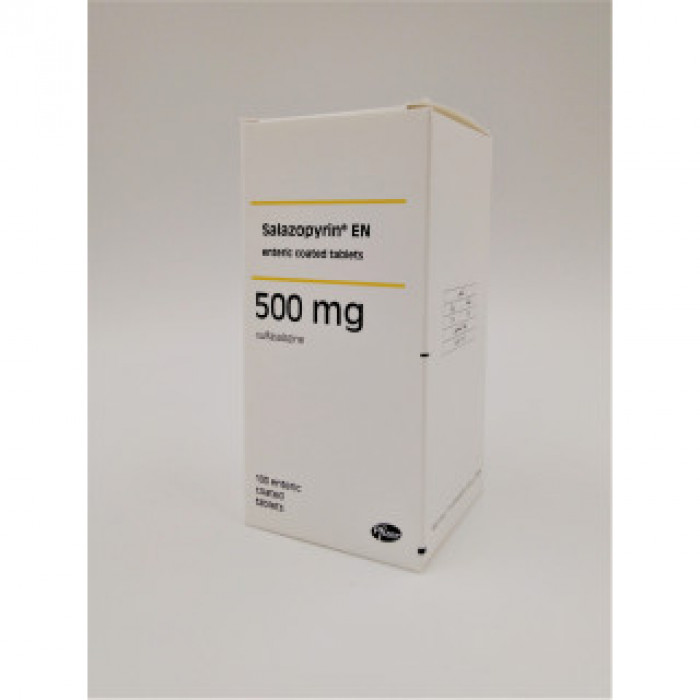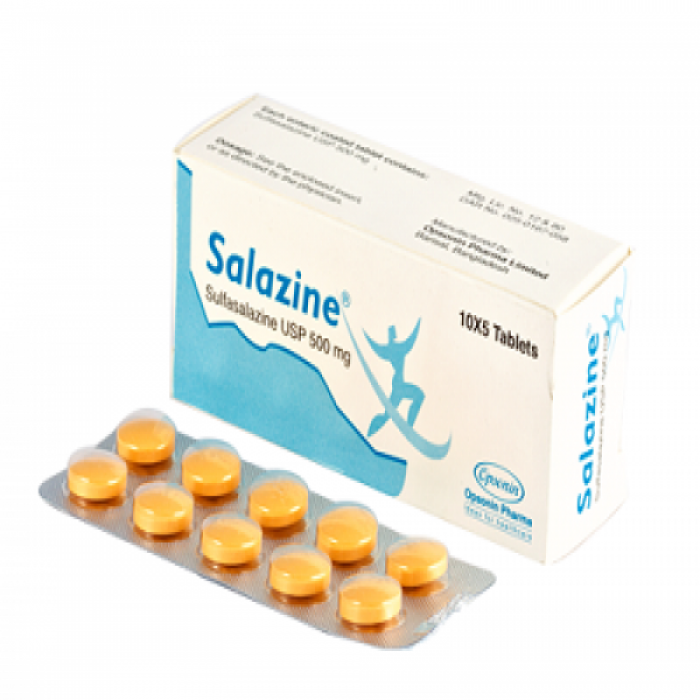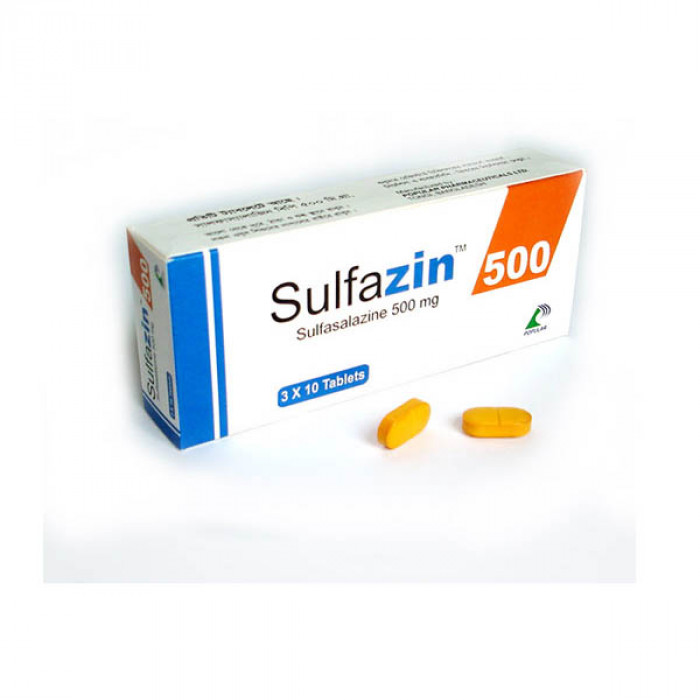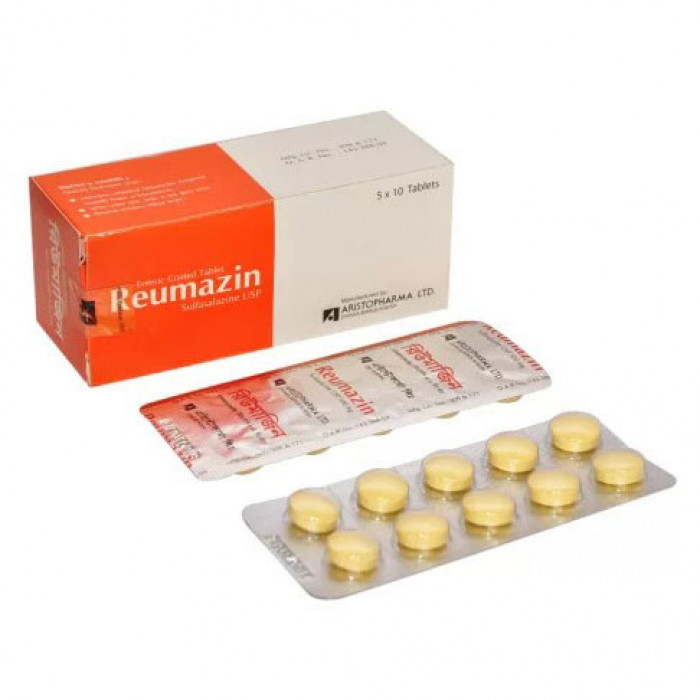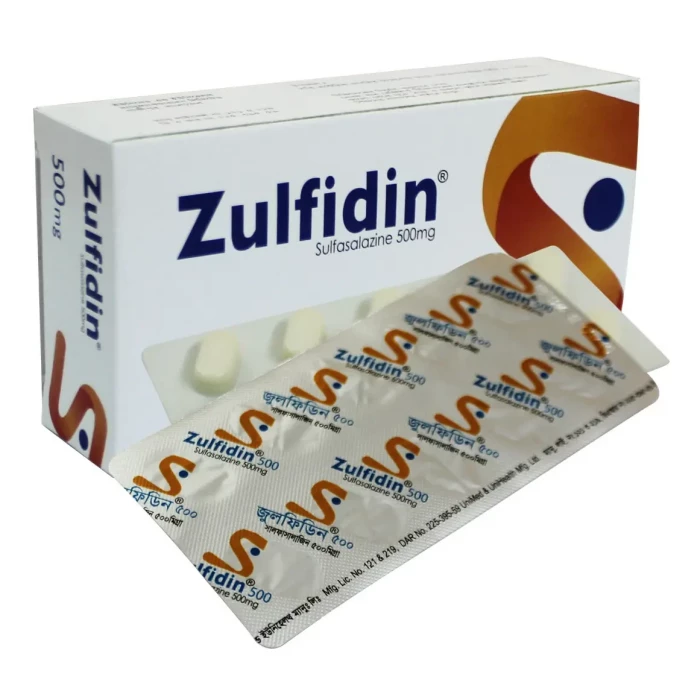
✔ 100% Authentic Product
👁️ Currently Viewing 2134
Zulfidin 500mg Tablet 10pcs
Sulfasalazine is primarily used for:
- Ulcerative Colitis: Reduces inflammation in the colon and rectum.
- Crohn's Disease: Treats chronic inflammation in the digestive tract.
- Rheumatoid Arthritis: Used when standard treatments fail to alleviate symptoms.
- Spondylitis: Relieves swelling and stiffness in the joints between vertebrae.
Discount
Price: ৳ 69
MRP:
৳
70
2%
Off

100% Genuine Products, Guaranteed

Safe & Secure Payments, Always

Fast, Secure & Efficient Delivery

Proper Packaging
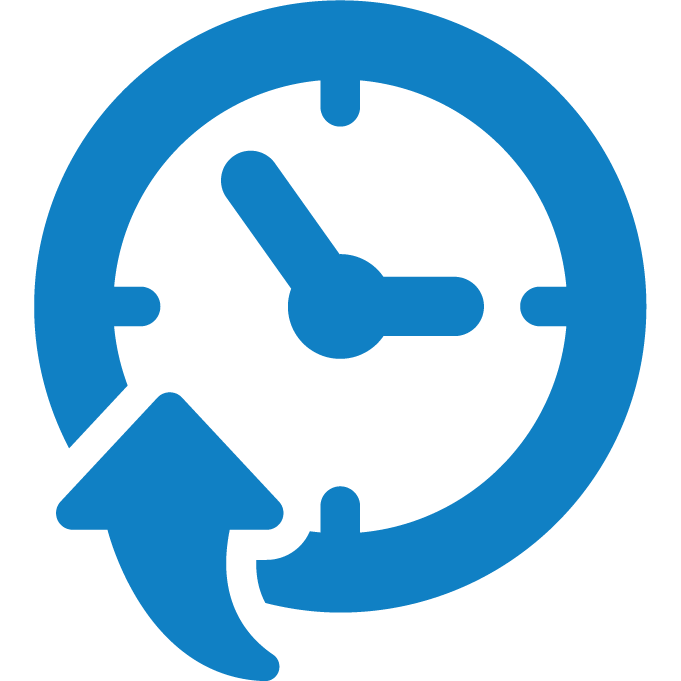 Cash on Delivery - All over Bangladesh
Cash on Delivery - All over Bangladesh Regular Delivery - 12-24 Hours, Dhaka City* Charge Tk.39-59
Regular Delivery - 12-24 Hours, Dhaka City* Charge Tk.39-59 Regular Delivery - 24-48 Hours, Other Cities* Charge Tk.99-110
Regular Delivery - 24-48 Hours, Other Cities* Charge Tk.99-110
 ফ্রি ডেলিভারিঃ - ৯৯৯ টাকা+ অর্ডারে, ঢাকা
শহরে
ফ্রি ডেলিভারিঃ - ৯৯৯ টাকা+ অর্ডারে, ঢাকা
শহরে ফ্রি ডেলিভারিঃ - ২৯৯৯ টাকা+ অর্ডারে, ঢাকার
বাহিরে
ফ্রি ডেলিভারিঃ - ২৯৯৯ টাকা+ অর্ডারে, ঢাকার
বাহিরে
100% Genuine Products, Guaranteed
Safe & Secure Payments, Always
Fast, Secure & Efficient Delivery
Proper Packaging
 Cash on Delivery - All over Bangladesh
Cash on Delivery - All over Bangladesh Regular Delivery - 12-24 Hours, Dhaka City* Charge Tk.39-59
Regular Delivery - 12-24 Hours, Dhaka City* Charge Tk.39-59 Regular Delivery - 24-48 Hours, Other Cities* Charge Tk.99-110
Regular Delivery - 24-48 Hours, Other Cities* Charge Tk.99-110 ফ্রি ডেলিভারিঃ - ৯৯৯ টাকা+ অর্ডারে, ঢাকা
শহরে
ফ্রি ডেলিভারিঃ - ৯৯৯ টাকা+ অর্ডারে, ঢাকা
শহরে ফ্রি ডেলিভারিঃ - ২৯৯৯ টাকা+ অর্ডারে, ঢাকার
বাহিরে
ফ্রি ডেলিভারিঃ - ২৯৯৯ টাকা+ অর্ডারে, ঢাকার
বাহিরে
✅ Description:
Zulfidin 500 is prescribed for the treatment of bowel diseases such as ulcerative colitis and Crohn's disease, as well as skin conditions like psoriasis and chronic joint disorders, including rheumatoid arthritis and ankylosing spondylitis, in both children and adults.
Zulfidin 500 reduces inflammation, primarily by inhibiting the production of prostaglandins—a chemical responsible for pain and inflammation. As a result, it helps alleviate inflammation in the intestines, skin, and joints.
Your doctor will determine the appropriate dosage and frequency based on your condition. Common side effects of Zulfidin 500 Tablet include sore throat, fever, unexplained bruising, or ringing in the ears (tinnitus). These side effects are typically mild and resolve independently, but you should consult your doctor if they persist.
Zulfidin 500 Tablet may temporarily lower sperm count, which can reduce male fertility. If this concerns you, discuss it with your doctor. A blood test may be recommended before starting the medication. Zulfidin 500 tablets can be used during pregnancy to prevent disease flare-ups. However, your doctor may also recommend additional folic acid supplements since the medication can lower folic acid levels. It is generally safe to use while breastfeeding, except in cases where the baby is premature or at risk of jaundice.
Safety Advices

Alcohol
UNSAFE
Avoid to consume alcohol with Zulfidin 500.

Pregnancy
CONSULT YOUR DOCTOR
Inform your doctor if you are pregnant or planning to have a baby before taking Zulfidin 500. Your doctor will decide whether to take it or not.

Breastfeeding
CONSULT YOUR DOCTOR
Avoid breastfeeding while taking Zulfidin 500 as there have been reports of diarrhea or blood in the stools of babies. Consult your doctor before taking it.

Driving
CAUTION
Zulfidin 500 is unlikely to affect your ability to drive or use machines.

Kidney
CONSULT YOUR DOCTOR
Zulfidin 500 should be used with caution in patients with kidney disease. Consult your doctor before taking.
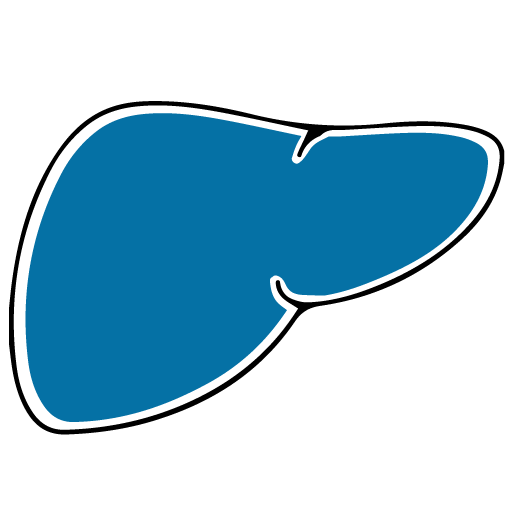
Liver
CONSULT YOUR DOCTOR
Zulfidin 500 should be used with caution in patients with liver disease. Consult your doctor before taking.
✔️ Uses of Zulfidin 500
- Ulcerative colitis
- Crohn’s disease
- Rheumatoid arthritis
✔️ How does Zulfidin 500 work?
works by suppressing the overactivity of the immune system in autoimmune diseases and blocks the chemical messengers that cause inflammation (swelling).
✔️ Side Effects: Zulfidin 500
- Headache
- Indigestion
- Nausea
- Watery diarrhoea
✔️ Pharmacology
The exact mode of action of Sulfasalazine is still being studied. However, it is believed to work through its anti-inflammatory and/or immunomodulatory properties, which have been observed in both animal and in vitro models. Other potential mechanisms include:
- Affinity for Connective Tissue: Sulfasalazine has been found to bind to connective tissue.
- High Concentrations in Specific Areas: It accumulates in serous fluids, the liver, and intestinal walls, as demonstrated by autoradiographic studies in animals.
Ulcerative Colitis:
Clinical studies involving the rectal administration of Sulfasalazine, its metabolite Sulfapyridine, and 5-aminosalicylic Acid (5-ASA) suggest that the primary therapeutic effect is due to the 5-aminosalicylic Acid moiety.
Rheumatoid Arthritis:
The specific contributions of Sulfasalazine and its major metabolites to the treatment of rheumatoid arthritis remain unknown. Further research is needed to understand its precise mechanism in this condition.
✔️ Important Notes:
- Dosage should be adjusted based on individual response and tolerance.
- Always consult with a healthcare provider before starting or adjusting the dosage.
- Regular monitoring of blood, liver, and kidney function is recommended during treatment.
✔️ Dosage & Administration of Zulfidin 500
The dosage of Sulfasalazine tablets should be tailored to each patient based on their tolerance and response to treatment. It is typically taken in evenly divided doses, preferably after meals, to reduce gastrointestinal discomfort.
Dosage Guidelines:
For Crohn’s Disease (Adults):
- Dosage: 500 mg orally, 2 to 4 times a day with food.
For Ulcerative Colitis (Pediatrics - Age 6 and Older):
- Initial Dose: 40 to 60 mg/kg/day, divided into 3 to 6 doses.
For Rheumatoid Arthritis (Adults):
- Maintenance Dose: 2 g daily, divided into two doses.
- Initial Therapy: Start with a lower dose (0.5 to 1 g daily) to minimize gastrointestinal intolerance.
- Suggested Schedule:
- First Week: One tablet in the evening.
- Second Week: One tablet in the morning and one in the evening.
- Third Week: One tablet in the morning and two in the evening.
- Fourth Week: Two tablets in the morning and two in the evening.
For Rheumatoid Arthritis (Pediatrics - Age 6 and Older):
- Initial Dose: 10 mg/kg/day, divided into two equal doses.
For Juvenile Rheumatoid Arthritis (Polyarticular Course):
- Children (Age 6 and Older): 30 to 50 mg/kg/day, divided into two doses.
- Maximum Dose: Typically 2 g/day.
For Other Indications:
- Initial Therapy:
- Adults: 3 to 4 g daily, divided into doses at intervals not exceeding 8 hours. Start with a lower dose (1 to 2 g daily) to reduce gastrointestinal intolerance.
- Children (Age 6 and Older): 40 to 60 mg/kg/day, divided into 3 to 6 doses.
- Maintenance Therapy:
- Adults: 2 g daily.
- Children (Age 6 and Older): 30 mg/kg/day, divided into 4 doses.
✔️ Inform your doctor if you are currently taking any of the following medications:
- Medications for high blood sugar: Examples include metformin and glipizide.
- Digoxin: Used for managing heart failure.
- Folic acid or folate supplements: For reducing the risk of neural tube defects (e.g., in conditions like spina bifida).
- Azathioprine and mercaptopurine: These medications suppress the immune system, often used in organ transplantation and chronic inflammatory conditions such as rheumatoid arthritis.
- Methotrexate: Commonly prescribed for managing rheumatoid arthritis.
- Methenamine: Used for the treatment of urinary tract infections (UTIs).
✔️ Overdosage Instructions:
- If you or someone else accidentally consumes too much of Zulfidin 500, seek immediate medical attention or visit the nearest hospital.
- Symptoms of overdose: These may include nausea and vomiting.
✔️ Storage
- Keep Zulfidin 500 out of reach of children
- Store below 25°C
⚠️Disclaimer:
At ePharma, we’re committed to providing accurate and accessible health information. However, all content is intended for informational purposes only and should not replace medical advice from a qualified physician. Please consult your healthcare provider for personalized guidance. We aim to support, not substitute, the doctor-patient relationship.




